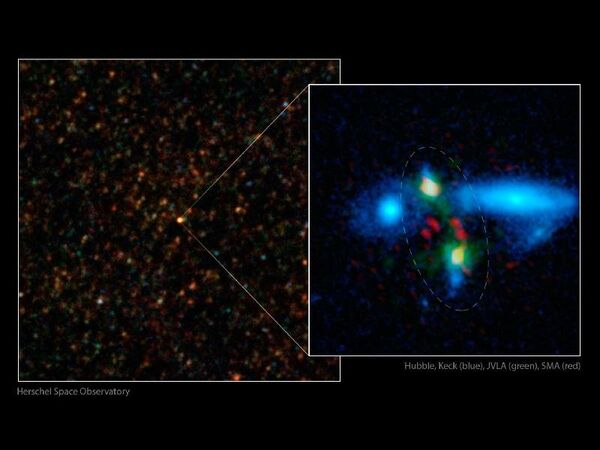WASHINGTON, May 23 (RIA Novosti) – US researchers have captured rare images of the creation of a massive galaxy about 10 times the size of the Milky Way that was formed when two young galaxies collided 11 billion years ago, a study published this week says.
“Capturing the creation of this type of large, short-lived star body is extremely rare – the equivalent of discovering a missing link between winged dinosaurs and early birds,” the University of California, Irvine (UCI) scientists who made the discovery said in a statement posted on UCI’s website.
The new mega-galaxy was originally spotted by a post-doctoral researcher at UCI in an image recorded by the European Space Agency’s Herschel telescope.
The researcher, Julie Wardlow, “noticed an amazing, bright blob” that stood out among the “carpets of galaxies” that Herschel had recorded.
Follow-up studies by other telescopes, including NASA’s Hubble and Spitzer space telescopes, confirmed that two galaxies, “located about 11 billion light-years from Earth, during a time when our universe was about 3 billion years old,” were “intertwined and furiously making stars” at a rate of about 2,000 stars a year, NASA said in a statement about the discovery. The Milky Way only produces two to three new stars a year, NASA said.
Eventually, the two hyperactive galaxies will calm down and form a giant elliptical galaxy according to astronomers.
“This monster system of interacting galaxies is the most efficient star-forming factory ever found in the universe at a time when it was only 3 billion years old,” said Hai Fu, a postdoctoral researcher at UCI and lead author of the study, which was published this week in the journal Nature.
The discovery of the space megamerger helps to shed light on an astronomical mystery that scientists have pondered for years, namely how were large elliptical galaxies formed in the early universe?
Most large galaxies are either spirals that are full of gas, like the Milky Way, or ellipticals, populated by old cool red stars and showing few signs of ongoing star formation.
“It was long assumed that the large elliptical galaxies seen in the universe today built up gradually over time via the gravitational acquisition of many small dwarf galaxies,” the European Space Agency said in a statement about the discovery.
But the fact that the collision of the two galaxies happened when the universe was just three to four billion years old suggests that massive mergers in space could, in fact, be responsible for giant elliptical galaxies forming in such a “short” cosmological time frame as a few billion years.
Video: A simulation of the merger of two galaxies to form a mega-galaxy, sped up to compress 1.5 billion years into seconds.


